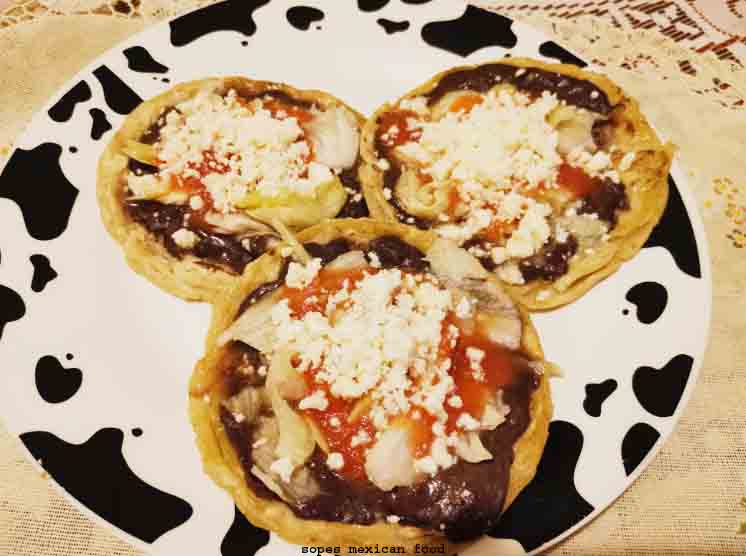
Introduction:
Sopes Mexican Food. Mexican cuisine is a vibrant tapestry of flavors, colors, and textures, with each dish telling a story of tradition, culture, and culinary expertise. Among the myriad of Mexican delights, sopes stand out as a beloved and authentic street food that encapsulates the essence of Mexican gastronomy.
In this article, we will embark on a flavorful journey, exploring the history, ingredients, preparation, and regional variations of sopes, unraveling the secrets behind this delectable Mexican dish.
The Origins of Sopes: A Culinary Heritage
Sopes trace their roots back to the heart of Mexican culture, with a history deeply entwined with indigenous culinary traditions. The word “sope” itself is derived from the Nahuatl language, spoken by the Aztecs, where it means “masa” or “dough.” The dish is believed to have evolved from ancient corn-based dishes prepared by indigenous peoples, showcasing the importance of maize in Mexican cuisine.
The Foundation: Masa and Its Importance
At the core of every sope lies masa, a dough made from nixtamalized corn. Nixtamalization is a traditional process involving the cooking and soaking of corn in an alkaline solution, often lime-water, which not only enhances flavor but also unlocks essential nutrients. Masa serves as the canvas for sopes, providing the perfect base for the toppings that follow.
Crafting the Perfect Sopes: From Dough to Disk
Creating sopes is an art that requires skill and patience. The masa dough is formed into small, thick discs, typically around 4-6 inches in diameter. These discs are then pressed down with fingers or a tortilla press to create a shallow well, giving sopes their characteristic concave shape. The edges are pinched to create a raised border, ensuring that the toppings stay in place.
Cooking Techniques: Griddled Goodness
Sopes are traditionally cooked on a comal, a flat griddle used in Mexican kitchens. The griddling process imparts a delightful toasty flavor to the masa, creating a perfect balance between crispy edges and a soft, pillowy center. This cooking technique is crucial to achieving the distinct texture that sets sopes apart from other Mexican antojitos.
Sopes Toppings: A Symphony of Flavors
What truly elevates sopes to culinary greatness is the array of toppings that adorn their golden surfaces. The possibilities are endless, but certain ingredients are quintessential to a classic sope:
- Refried Beans: A smear of creamy refried beans serves as the foundation, adding richness and depth to each bite.
- Meat Varieties: From succulent shredded chicken to savory beef picadillo, the protein choices for sopes are diverse and flavorful. Each region in Mexico brings its own unique twist to the meat fillings.
- Fresh Vegetables: Sopes are often adorned with vibrant, fresh vegetables like lettuce, tomatoes, and radishes, providing a crisp contrast to the savory components.
- Cheese: Whether it’s crumbled queso fresco or melted Oaxaca cheese, dairy plays a crucial role in enhancing the overall richness of sopes.
- Salsas and Guacamole: No Mexican dish is complete without the bold flavors of salsa and guacamole. Sopes are no exception, with a variety of salsas ranging from mild to fiery, adding an extra kick to the dish.
- Regional Variations: A Culinary Tour of Mexico
One of the captivating aspects of Mexican cuisine is its regional diversity, and sopes are no exception. Each region puts its own spin on this beloved dish, creating a tapestry of flavors that reflects the unique culinary traditions of the area.
- Central Mexico: Here, sopes often feature toppings like tinga (shredded chicken in chipotle sauce), nopales (cactus), and salsa verde. The influence of Aztec and pre-Hispanic flavors is prominently felt in this region.
- Southern Mexico: Sopes in the south are known for their seafood toppings, such as shrimp or fish ceviche. The use of plantains and black beans also adds a tropical flair to the dish.
- Northern Mexico: Sopes in the north showcase the region’s love for grilled meats, with toppings like carne asada or machaca (dried and rehydrated beef). Flour-based sopes are more prevalent in this region, distinguishing them from their masa counterparts.
- Sopes Beyond Borders: A Global Appreciation
In recent years, Mexican cuisine has gained global acclaim, and sopes have become a symbol of the country’s rich culinary heritage. Mexican restaurants around the world offer their take on sopes, introducing international palates to the joyous explosion of flavors that this dish embodies.
Sopes in Festivities: A Symbol of Celebration
Sopes are not just a staple of everyday Mexican cuisine; they also play a significant role in festive occasions and celebrations. From street fairs to family gatherings, sopes are a versatile and crowd-pleasing dish that brings people together.
DIY Sopes: Bringing the Flavors of Mexico to Your Kitchen
For those eager to embark on a culinary adventure, making sopes at home can be a rewarding experience. This section will provide a step-by-step guide to crafting authentic sopes, from preparing masa dough to selecting the perfect toppings.
Sopes and Cultural Identity: A Culinary Connection
The cultural significance of sopes extends beyond the realm of food. In Mexico, the preparation and enjoyment of sopes are intertwined with social gatherings, storytelling, and the passing down of culinary traditions from one generation to the next. Sopes, in essence, are a celebration of cultural identity.
Sopes Mexican Food
Sopes, a traditional Mexican dish dating back to pre-Columbian times, have been captivating taste buds for centuries with their unique blend of flavors and textures. These delectable corn dough discs, topped with refried beans, meats, cheese, and fresh veggies, offer a mouthwatering experience that is hard to resist.
What sets sopes apart from other Mexican dishes is their thick base which provides a satisfying crunch on the outside while remaining soft and pillowy on the inside – an irresistible combination that keeps food enthusiasts coming back for more.
The versatility of sopes allows for endless flavor combinations and toppings, making them a customizable option for any palate. From spicy chorizo and tangy salsa to tender shredded chicken and creamy avocado slices, the possibilities are endless.
Whether enjoyed as an appetizer or a hearty meal, sopes never fail to deliver an explosion of authentic Mexican flavors that leave a lasting impression on anyone fortunate enough to indulge in this beloved culinary delight. So if you’re seeking an unforgettable dining experience that celebrates the vibrant gastronomic heritage of Mexico, look no further than the flavorful world of sopes.
Conclusion: Sopes – A Culinary Symphony
In the vast landscape of Mexican cuisine, sopes stand out as a culinary masterpiece, reflecting the rich tapestry of flavors, textures, and traditions that define this vibrant culture. From the humble streets of Mexico City to global kitchens, sopes have transcended borders,
bringing the joyous spirit of Mexican gastronomy to tables around the world. As we savor the crispiness of the masa, the richness of the toppings, and the explosion of flavors in each bite, we are not just indulging in a delicious dish; we are partaking in a culinary symphony that has been playing for centuries, telling the story of a people and their love for good food.











Thank you for your sharing. I am worried that I lack creative ideas. It is your article that makes me full of hope. Thank you. But, I have a question, can you help me?